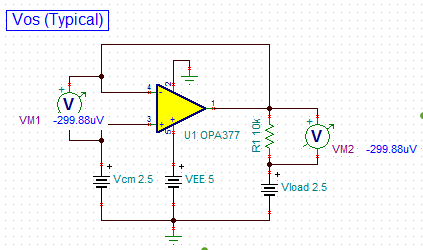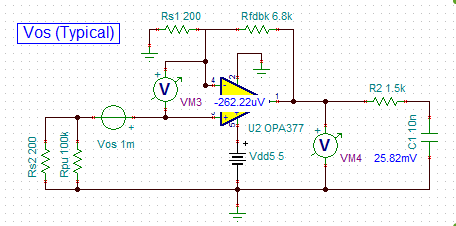Other Parts Discussed in Thread: TINA-TI,
Tool/software: TINA-TI or Spice Models
First of all, thank you for the TI Precision Labs! Really helpful.
Spoiler: As I was writing this question, I believe I found the answer...
I would like to confirm the impact of Vos to my circuit, simulate it if possible and eventually, to obtain a transfer function.
OPA377 simulation confirms the typical datasheet values. (See TI Precision Labs - Op Amps: Vos and Ib)
Following Bruce Trump suggestion (see related question) I inserted a voltage source in series with the positive input terminal of the OpAmp.
The circuit shown here is the superposition simplification of the circuit of interest, which only includes Vos.
As the gain is expected to be 1+(6.8k/200) = 35; I thought I would expect 35mV, but as you can see, the simulation shows 25.82mV
Then, I realized, this simulation model requires approximately 300uV to drive the output to Zero, thus I decided to run a "Vos" sweep, between -1mV and 1.3mV.
As expected, because my power rails work between 0 and 5V, I see "zero" until Vos is greater than 300uVL and I see 36.2mV output at 1.3mV Input
Questions
- Could this confirm my assumption that the Vos impact would be given by the following simple formula: Vout(Vos) = (1+6.8k/200) * Vos
- Why do I see a slight difference: 36.2mV (simulation) vs 35mV (Theoretical)
Thanks!
Alberto





